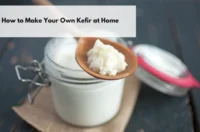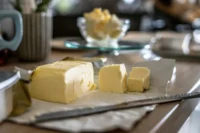
Storing Baby Formula in Mylar Bags
As a prepper, you understand the importance of being prepared for any situation. When it comes to ensuring that your baby’s nutritional needs are met

Making your own butter at home is a rewarding and surprisingly simple process. With just a few basic ingredients and tools, you can create rich, creamy butter that’s far superior to store-bought varieties. Whether you’re interested in traditional churning methods, using modern appliances, or exploring creative flavor additions, this guide will walk you through everything you need to know.
The cream should be at room temperature, ideally between 15°C to 18°C, when making butter. This temperature range allows the cream to churn efficiently, ensuring that the fat separates from the liquid to form butter.
If the cream is too cold, it will take much longer to churn, and the butter might not form properly. On the other hand, if the cream is too warm, the butter could become greasy and may not separate cleanly from the buttermilk.
So, before you start churning, let the cream sit out of the fridge for about 1-2 hours to reach the ideal temperature.
Before diving into the how-to, let’s talk about why you might want to make your own butter. Homemade butter not only tastes better but also allows you to control the ingredients, avoiding preservatives and additives. Plus, the leftover buttermilk can be used in various recipes, making the process both economical and versatile.
Traditional butter making is a nostalgic and hands-on way to create butter. Here’s how you can do it:
Ingredients for making butter:
Tools:
Steps:
For a quicker, less labor-intensive method, a stand mixer is a fantastic tool.
Ingredients:
Tools:
Steps:
Using a food processor is one of the fastest methods to make butter at home.
Ingredients:
Tools:
Steps:
Cultured butter has a tangy flavor and is made by fermenting the cream before churning. This method adds an extra step but is worth it for the unique taste.
Ingredients:
Tools:
Steps:
Once you’ve mastered basic butter, you can start experimenting with flavors. Add ingredients like fresh herbs, garlic, honey, or spices to create compound butters.
Ideas for Flavored Butter:
Homemade butter can be stored in the refrigerator for up to a week or frozen for longer storage. Use it just like store-bought butter—in baking, cooking, or simply spreading on a piece of fresh bread.
Making your own butter is not only a fun and satisfying process, but it also allows you to enjoy the freshest, most flavorful butter possible. Whether you stick to the basics or explore the world of flavored and cultured butters, the possibilities are endless. Try it out and bring a touch of homemade goodness to your kitchen!

As a prepper, you understand the importance of being prepared for any situation. When it comes to ensuring that your baby’s nutritional needs are met

If you’re a fan of probiotic-rich foods, you’ve probably heard of kefir. This tangy, fermented drink is packed with beneficial bacteria and yeast, making it

Making your own butter at home is a rewarding and surprisingly simple process. With just a few basic ingredients and tools, you can create rich,
We are on Maternity Leave. Shop is closed till the 25th of November. All incoming orders will be shipped when we're back :) Dismiss